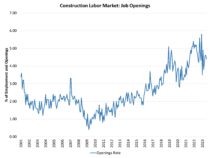The count of open, unfilled jobs for the overall economy continued to moved lower in July, falling to 8.8 million. While certain inflation readings have raised the likelihood of a September Federal Reserve interest rate increase, the JOLTS survey is another data point indicating an ongoing but gradual cooling of macro conditions due to elevated interest rates.
The count of open jobs was 11 million a year ago in July 2022. The count of total job openings will continue to fall in 2023 as the labor market softens and the unemployment rises. From a monetary policy perspective, ideally the count of open, unfilled positions slows to the 8 million range in the coming months as the Fed’s actions cool inflation. The economy is approaching that level according to this new data release.
While higher interest rates are having an impact on the demand-side of the economy, the ultimate solution for the labor shortage will not be found by slowing worker demand, but by recruiting, training and retaining skilled workers. This is where the risk of a monetary policy mistake can be found. Good news for the labor market does not automatically imply bad news for inflation.
The construction labor market continued to cool in July. The count of open construction jobs decreased to 363,000. This estimate comes after a data series high of 488,000 in December 2022. The overall trend is one of cooling for open construction sector jobs as the housing market slows and backlog is reduced, with a notable uptick in month-to-month volatility since late last year.
The construction job openings rate ticked down to 4.4% in July. The recent trend of these estimates points to the construction labor market having peaked in 2022 and is now entering a stop-start cooling stage as the housing market adjusts to higher interest rates.

Despite additional weakening that will occur in the second half of 2023, the housing market remains underbuilt and requires additional labor, lots and lumber and building materials to add inventory. Hiring in the construction sector ticked up to 4.8% in July after a 4.7% reading in June. The post-virus peak rate of hiring occurred in May 2020 (10.4%) as a post-covid rebound took hold in home building and remodeling.
Construction sector layoffs increased to 1.8% in July. In April 2020, the layoff rate was 10.8%. Since that time, the sector layoff rate has been below 3%, with the exception of February 2021 due to weather effects and March 2023 due to some market churn.
Looking forward, attracting skilled labor will remain a key objective for construction firms in the coming years. While a slowing housing market will take some pressure off tight labor markets, the long-term labor challenge will persist beyond the ongoing macro slowdown.


The data in this article indicating a cooling labor market can have implications for construction loans. With potential labor shortages, it’s crucial for construction project planning to factor in possible delays and increased labor costs, which can impact the financing needs and terms of construction loans.